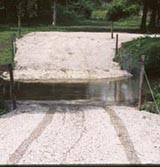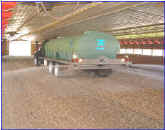Research Information
|
|
 Laboratory and in-situ reductions of soluble phosphorus in liquid swine waste slurries, struvite precipitation or aluminum phosphate precipitation. Two slurry amendments have been tested to reduce soluble phosphorus concentrations in swine waste. Both studies involved laboratory scale beaker tests and large scale field tests. Struvite is formed by adding MgCl2 and aluminum phosphate is formed by adding AlCl3 . Laboratory and in-situ reductions of soluble phosphorus in liquid swine waste slurries, struvite precipitation or aluminum phosphate precipitation. Two slurry amendments have been tested to reduce soluble phosphorus concentrations in swine waste. Both studies involved laboratory scale beaker tests and large scale field tests. Struvite is formed by adding MgCl2 and aluminum phosphate is formed by adding AlCl3 . |
 Performance testing of solid separators for industry. Performance testing of solid separators for industry.(See performance testing and nutrient partitioning poster). A performance test protocol has been developed in order to analyze each separator system on an equal basis. To date, two screw press separators have been tested at the University of Tennessee Dairy Experiment Station in Lewisburg. In December of 2000, a Vincent KP-6 was tested. In June of 2001, a Press Tech Agri-Press preceeded by a Bauer hydra-sieve static screen (side hill) was tested. |
 Quantifying and minimizing 17b-estradiol discharges from dairy and swine waste. Hormonal pollution of the environment has been implicated in human and wildlife health problems. However, little is known regarding the environmental impact of hormones originating from animals. Current regulations are driven by concerns about nutrients (notably P & N), pathogens, and organic matter with no consideration given to the impact of these regulations on environmental loads. Quantifying and minimizing 17b-estradiol discharges from dairy and swine waste. Hormonal pollution of the environment has been implicated in human and wildlife health problems. However, little is known regarding the environmental impact of hormones originating from animals. Current regulations are driven by concerns about nutrients (notably P & N), pathogens, and organic matter with no consideration given to the impact of these regulations on environmental loads. |
 Periodic Draining of Constructed Wetland Mesocosms Treating Dairy Wastewater: Impact on Mosquito Populations and Pollutant Removal. Periodic Draining of Constructed Wetland Mesocosms Treating Dairy Wastewater: Impact on Mosquito Populations and Pollutant Removal. |
 Using Fuzzy Logic to Determine Failure Modes in a Biological Sensor for UASB Reactors. High-rate anaerobic processes offer many advantages over aerobic wastewater treatment processes. However, a serious disadvantage to high-rate anaerobic processes is the subsequent slow start-up of the reactor (re-growth of the microorganisms) following a failure. Reactor failures result from toxic loads. A biological sensor is in development to rapidly detect toxic loads in influent wastewater. Using Fuzzy Logic to Determine Failure Modes in a Biological Sensor for UASB Reactors. High-rate anaerobic processes offer many advantages over aerobic wastewater treatment processes. However, a serious disadvantage to high-rate anaerobic processes is the subsequent slow start-up of the reactor (re-growth of the microorganisms) following a failure. Reactor failures result from toxic loads. A biological sensor is in development to rapidly detect toxic loads in influent wastewater. |
 Reducing Dairy Lagoon Organic Loading Rates With High-Rate Anaerobic Digesters. In a two-stage study, the possibility of using high-rate anaerobic digesters to reduce dairy lagoon organic loading rate was explored. Four anaerobic sequencing batch reactors (ASBR) and four downflow anaerobic filters (DFAF) were tested. The experiment demonstrated that settling processes, rather than biodegradation, accounted for most of the organic matter reduction. Also, of the experiment explored the possibility of removing volatile fatty acids (VFA) from synthetic dairy lagoon supernatant. Reducing Dairy Lagoon Organic Loading Rates With High-Rate Anaerobic Digesters. In a two-stage study, the possibility of using high-rate anaerobic digesters to reduce dairy lagoon organic loading rate was explored. Four anaerobic sequencing batch reactors (ASBR) and four downflow anaerobic filters (DFAF) were tested. The experiment demonstrated that settling processes, rather than biodegradation, accounted for most of the organic matter reduction. Also, of the experiment explored the possibility of removing volatile fatty acids (VFA) from synthetic dairy lagoon supernatant. |
Research Subsites


 Liquid aluminum sulfate use in broiler production houses to control in-house ammonia and naturally occurring pathogens. Dry granular alum has been used effectively as a broiler litter amendment to reduce ammonia volatilization in production houses. Some broiler houses are using liquid alum, but no published information is available concerning its use in treating broiler litter. Likewise, information has not been published on the use of liquid alum to reduce Salmonella and Campylobacter.
Liquid aluminum sulfate use in broiler production houses to control in-house ammonia and naturally occurring pathogens. Dry granular alum has been used effectively as a broiler litter amendment to reduce ammonia volatilization in production houses. Some broiler houses are using liquid alum, but no published information is available concerning its use in treating broiler litter. Likewise, information has not been published on the use of liquid alum to reduce Salmonella and Campylobacter.